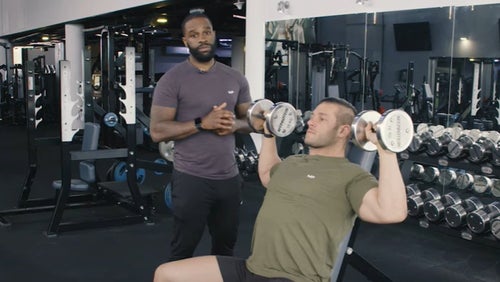
Strength training is a very effective routine that can help improve your body, health, and overall quality of life. Whether you’re a complete beginner or a seasoned athlete – incorporating this training style is a must.
This comprehensive guide will walk you through everything you need to know about strength training, helping you design a rock-solid program tailored to your goals.
- The Benefits of Strength Training
- Understanding the Basics of Strength Training
- Setting Goals for Your Strength Training Program
- Key Principles of Effective Strength Training
- Types of Strength Training Programs
- Designing Your Strength Training Schedule
- Essential Strength Training Exercises
- Strength Training for Beginners
- Advanced Strength Training Techniques
- The Role of Warm-Ups and Cool-Downs in Strength Training
- Equipment Needed for Strength Training
- Progressive Overload: How to Keep Gaining Strength
- Recovery and Rest: Essential for Muscle Growth
- Nutrition Tips for Strength Training
- Tracking Progress and Adjusting Your Program
- Incorporating Cardio into a Strength Training Program
- Strength Training for Specific Goals
- Common Mistakes in Strength Training and How to Avoid Them
- Using Technology to Enhance Your Strength Training Program
The Benefits of Strength Training
Strength training hosts several benefits ranging from boosted metabolism to improved overall health. Here are a few in a little more detail:
Increased muscle mass: Strength training stimulates muscle growth, leading to increased muscle size, density, and strength. Improved bone density: Lifting weights increases bone density, reducing the risk of osteoporosis and fractures. Enhanced metabolism: Muscle is metabolically active, meaning the more muscle you have, the more calories you burn at rest. Better mental health: Strength training has been shown to reduce symptoms of anxiety and depression, boosting overall mental well-being. Injury prevention: Strengthening muscles, tendons, and ligaments helps protect against injuries during other physical activities. Improved functional fitness: Strength training enhances your ability to perform everyday tasks, making activities like lifting groceries or climbing stairs easier. Cardiovascular health: While not traditionally associated with cardiovascular fitness, strength training can improve heart health by lowering blood pressure and improving cholesterol levels.
Understanding the Basics of Strength Training
Before planning a fully-fledged routine, it’s important to understand the basics of this style of training.
Resistance is the core aspect of strength training, with the aim to challenge your body, and muscles in particular, in order to develop further.
To put it simply - aim to lift something heavy, the body will eventually adapt by repairing and growing more muscle fibers to lift heavier. Here are some easy ways to make your fitness program more strength-focused:
Repetitions (Reps): The number of times you perform a specific movement, aim for 3-5 reps in your training. Sets: A group of repetitions performed consecutively without rest. Aim for 2-3 sets for beginners, up to 5 sets for seasoned lifters, and up to 7 for advanced. Rest intervals: The time taken to recover between sets or exercises—the aim is to rest enough to be able to lift maximally on your next set (3-5 mins between sets). Resistance: The amount of weight used in an exercise. This is normally a percentage of your maximal strength/load you can lift. Aim for 80% or more, although this can be lowered to 70% for beginners to see improvements. Progression: Gradually increasing the resistance or intensity of your workouts over time to continue making gains. Progressive overload is a highly popular strategy to make this happen successfully.
The difference between strength and resistance training
Put simply, all strength training is resistance training, but not all resistance training is strength training.
Strength training requires resistance movements, but due to the highly specific goal of building strength, there is a focus on utilizing heavy weights and progressive overload.
You can perform resistance exercises using bodyweight or low weights with an increased tempo of repetition as a means of building endurance, but this type of resistance training would not directly benefit strength goals.
Setting Goals for Your Strength Training Program
Setting clear, realistic goals is essential for the success of your strength training program.
Your goals will guide your workout routine, influencing the exercises you choose, number of sets and reps, and workout frequency.
This could be either a certain exercise in the gym to lift more or an increase in reps, or even something that makes day-to-day life a little easier like climbing stairs, for example. Make sure a goal you set is realistic and achievable in a set amount of time to keep on track.
Key Principles of Effective Strength Training
To get the most out of your strength training program, it’s important to adhere to the following key principles:
Specificity: Your training should be specific to your goals. For example, if you want to build muscle mass, your program should focus on hypertrophy-specific exercises and rep ranges. Overload: To make progress, you need to gradually increase the resistance or intensity of your workouts, also known as progressive overload. Variation: Incorporating different exercises, rep ranges, and training methods can prevent plateaus and keep your workouts interesting. Recovery: Adequate rest and recovery are crucial for muscle growth and avoiding injury. This includes nutrition to fuel muscle growth and repair. Consistency: Regular training is essential for making steady progress.

Progressive Overload | What is it?
Elevate your training plan with progressive overload....
Types of Strength Training Programs
Different types of strength training programs cater to different goals and preferences. The main advice is to aim to train each muscle group or movement at least twice per week, depending on your recovery duration and level.
Here are some of the most common approaches:
Full-body workouts
Full-body workouts target all major muscle groups in one session. They’re ideal for beginners or those with limited training time. For optimal recovery between sessions, aim to train 2-3 times a week.
Split routine programs
This routine divides the body into different muscle groups, allowing you to focus on specific areas each session. An example of this would be:
- Day one – chest
- Day two – legs
- Day three – back
Training splits are more popular among intermediate-advanced lifters looking to increase their training volume and have the time, nutrition, and supplement routine to benefit from it. Examples of the supplements would be:
- Creatine
- HMB
- Complete protein powders
Push-pull workouts
This routine is effective in balancing your muscle development by splitting your workouts depending on the muscles used. Such as:
Push day
- Bench press
- Shoulder press
- Extensions
Pull day
- Dumbbell curls
- Lat pulldowns
- Rows
You can also add in a separate lower body day or take squats into the push day and deadlifts into the pull day.

Master the Push, Pull, Legs Workout Split for Muscle Growth
The most efficient workout split for building mass....
Designing Your Strength Training Schedule
Now, with designing your schedule, take your goals, experience, and available training time. Here’s a basic template you can follow:
- Beginners – 2-3 full body workouts per week, focusing on compound movements.
- Intermediate – 3-4 workouts per week, using a split routine (upper/lower or push/pull).
- Advanced – 4-6 workouts per week, with more specialized splits and additional accessory work.
Ensure that each muscle group is trained 2-3 times per week and allow at least 48 hours recovery between sessions targeting the same muscle group.
Essential Strength Training Exercises
To easily focus on essential exercises that target major muscle groups, you can divide them into two categories – compound movements and isolation exercises. Here’s some more detail on both:
Compound movements
These movements involve multiple joints and muscle groups, making them highly effective for building strength and mass. Key compound exercises include:
- Squats: Target the quads, hamstrings, glutes, and core.
- Deadlifts: Work the entire posterior chain, including the back, glutes, and hamstrings.
- Bench Press: Primarily targets the chest, shoulders, and triceps.
- Pull-Ups: Engage the back, shoulders, and biceps.
- Overhead Press: Focuses on the shoulders, triceps, and upper chest.
- Rows: Target the back, biceps, and shoulders.

Benefits Of Compound Movement Exercises | Build Mass, Burn Fat
All of the best compound movements....
Isolation exercises
These target a single muscle group and joint, which is useful for addressing imbalances or adding accessories to workouts to overtrain an area to build it up. Exercises include:
- Tricep Extensions: Target the triceps to support pressing movements.
- Leg Curls: Isolate the hamstrings and support deadlifting.
- Leg Extensions: Focus on the quadriceps and support squatting patterns.
- Lateral Raises: Target the shoulders and pressing overhead.
- Reverse Fly: Targets traps and rhomboids and supports pulling and posture.
Strength Training for Beginners
If you’re new to strength training, starting with a simple program and focusing on mastering basic movements can build a solid foundation of strength. Here are some tips:
- Start with bodyweight exercises: Before adding external resistance, master bodyweight exercises like squats, push-ups, and planks.
- Learn proper form: Work with a trainer or use reputable resources to ensure you're performing exercises with correct form to prevent injury.
- Focus on compound movements: Prioritize compound exercises that target multiple muscle groups.
- Gradually increase intensity: Start with lighter weights and gradually increase the resistance as you become more comfortable with the exercises.
- Be consistent: Aim to train 2-3 times per week, focusing on full-body workouts.
Advanced Strength Training Techniques
For experienced lifters looking to break through plateaus and achieve new levels of strength and muscle growth, advanced techniques can be highly effective:
- Supersets: Perform two exercises back-to-back with minimal rest, targeting opposing muscle groups for a better strength benefit.
- Pyramid sets: Gradually increase the weight with each set while decreasing the reps, more advanced lifters might then reverse the process as well.
- Rest-pause training: For strength training, split a set of 6-10 reps into blocks of 2-3 reps, resting around 10-20 seconds between blocks. Your load should be around 80% minimum here, in which you wouldn’t be able to complete all the sets without break. Then rest for 3-5 mins.
- Negatives: Focus on the eccentric (lowering) phase of a lift, which can help build strength and muscle. You can overload on this phase (up to 120% 1RM) as long as you have a spotter on the way up!
The Role of Warm-Ups and Cool-Downs in Strength Training
Warming up before a workout and cooling down afterward are essential components of a safe and effective strength training program:
- Warm-up: A proper warm-up increases blood flow to the muscles, improving flexibility while reducing injury risk. Include dynamic stretches and light cardio for 5-10 mins to help coordination and activation of muscles—it will help you lift more.
- Cool-down: Helps gradually lower your heart rate and prevent blood pooling in the muscles. Include static stretches for the major muscle groups worked during your session, holding each stretch for 20-30 seconds to help increase flexibility.
Proper form and technique
This is critical to maximize the effectiveness of your workouts and to prevent injuries.
Make sure you have a point of reference for each exercise to compare to, whether it’s seeing yourself in the mirror, a video, or a photo. Here are some general guidelines.
- Start light: Begin with lighter weights to develop correct form before progressing to heavier reps.
- Use full range of motion: Perform exercises through the full range of motion to engage all muscle fibers and improve flexibility.
- Control the movement: Avoid using momentum; instead, focus on slow, controlled movements to almost pause at the bottom of movements.
- Listen to your body: If an exercise causes pain (beyond typical muscle soreness), stop and reassess your form, and consider consulting a professional.
Equipment Needed for Strength Training
The equipment you need for strength training depends on your goals, budget, and available space. Here’s a basic list:
- Dumbbells: Versatile and essential for a wide range of exercises.
- Barbell and weight plates: Ideal for heavy compound lifts like squats, deadlifts, and bench presses.
- Resistance bands: Great for adding resistance or assistance in bodyweight exercises.
- Bench: Useful for a variety of exercises, including presses, rows, and step-ups.
- Pull-up bar: Essential for bodyweight exercises like pull-ups and chin-ups.
- Kettlebells: Useful for dynamic exercises like swings, snatches, and Turkish get-ups.
- Machines: While not essential, machines can provide additional support and variety to your workouts, especially for isolation exercises.
A membership to a gym can be useful for gaining access to a wider range of equipment without the need to purchase or store them in your home.
Bodyweight vs free weights vs machines
Different types of resistance training tools offer unique benefits:
- Bodyweight: Ideal for beginners and those with limited equipment, bodyweight exercises improve functional strength and flexibility.
- Free weights: Offer the greatest versatility and the ability to engage stabilizer muscles, making them effective for building strength and muscle.
- Machines: Provide support and guidance, making them suitable for beginners or for isolating specific muscles. However, they may not engage stabilizer muscles as effectively as free weights.
Progressive Overload: How to Keep Gaining Strength
Progressive overload is the gradual increase of stress placed on the body during training. To continue gaining strength, you need to consistently challenge your muscles by:
- Increasing weight: Gradually add more weight to your lifts.
- Increasing volume: Add more sets or reps to your workouts.
- Increase speed: Move or at least try to move the weight as fast as you can (even if it feels slow) without sacrificing proper form.
- Decreasing rest time: Shorten rest intervals between sets to increase intensity (be careful not to go too short or you might lose strength improvements).
Recovery and Rest: Essential for Muscle Growth
Recovery is just as important as the workout itself. Your muscles need time to repair and grow stronger, which occurs during periods of rest. To optimize recovery:
- Sleep: Aim for 7-9 hours of quality sleep per night to support muscle repair and hormone production.
- Nutrition: Consume adequate protein, carbohydrates, and fats to fuel recovery and muscle growth. When building muscle, you will likely be aiming for 1.2-1.8g of protein per KG of bodyweight every day.
- Active recovery: Engage in low-intensity activities like walking, swimming, or yoga to promote blood flow and reduce muscle soreness.
- Rest days: Incorporate at least one or two rest days per week to allow your muscles to recover as well as your immune system.

The Right Recovery for Your Body
maximize recovery potential to power your progress......
Nutrition Tips for Strength Training
Nutrition plays a critical role in your strength training success. Here are some tips to optimize your diet for strength gains:
- Protein intake: Aim for 1.2-1.8 grams of protein per kilogram of body weight per day to support muscle repair and growth.
- Carbohydrates: Consume enough carbs to fuel your workouts and replenish glycogen stores (however, this would be dependent on your aesthetic aims and your day-to-day activities).
- Fats: Include healthy fats in your diet for hormone production and overall health. The focus is on unsaturated fats which you can find in plants, seeds, and oily fish. Saturated fat doesn’t have to be avoided but limit intake.
- Hydration: Stay hydrated, as even mild dehydration can impair performance.
- Pre- and post-workout nutrition: Eat a balanced meal with protein and carbs 2-3 hours before your workout and a post-workout meal or shake within 1-2 hours after training.
Tracking Progress and Adjusting Your Program
Tracking your progress is essential for staying motivated and ensuring your program is effective. Here’s how to do it:
- Keep a workout log: Record your exercises, sets, reps, and weights used. Make sure you look at long term changes rather than week to week where you could decrease slightly just based on how you feel on the day.
- Monitor physical changes: Take regular measurements, photos, and track body weight to assess progress.
- Adjust as needed: If you’re not seeing the results you want, consider changing your program's volume, intensity, or exercises.
- Set milestones: Break down your goals into smaller milestones to celebrate progress and stay motivated.
Incorporating Cardio into a Strength Training Program
It’s crucial for your overall health but can also complement your strength training. Here’s how you can integrate cardio without compromising strength gains:
- Separate sessions: Perform cardio on different days than strength training or in a separate session (e.g., strength in the morning, cardio in the evening).
- Low-intensity cardio: Incorporate low-intensity steady-state (LISS) cardio like walking or cycling to improve cardiovascular health without impacting recovery.
- High-intensity interval training (HIIT): Use HIIT sparingly to boost cardiovascular fitness without sacrificing muscle gains.

5 Cardio Exercises To Retain And Build Muscle
"Cardio leads to muscle loss." Think again....
Strength Training for Specific Goals
Depending on your goals, your strength training program will vary. Here are some approaches for different objectives:
To build muscle mass (hypertrophy), focus on:
- Moderate weight, higher reps: 6-12 reps per set.
- Multiple sets: 3-5 sets per exercise.
- Short rest periods: 30-90 seconds between sets.
For athletic performance, incorporate:
- Explosive movements: Plyometrics, Olympic lifts, and sprints.
- Sport-specific exercises: Tailor exercises to the demands of your sport.
To improve functional strength, focus on:
- Compound movements: Exercises that mimic everyday activities (e.g., deadlifts, squats, lunges).
- Unilateral training: Single-leg or single-arm exercises to address imbalances.
- Stability work: Use unstable surfaces (e.g., stability balls) to improve balance and core strength.
For increased powerlifting scores, add in:
- The main lifts (squats, deadlifts, and bench press each week).
- Add accessory lifts to hit muscles for a second time in the week.
Common Mistakes in Strength Training and How to Avoid Them
Avoid these common mistakes to improve the success of your strength training program:
- Poor form: Learn the correct technique to prevent injuries.
- Skipping warm-up and cool-down: Always warm up before and cool down after your workouts to avoid injuries and imbalances.
- Neglecting recovery: Overtraining can lead to burnout and injury.
- Lack of progression: Continuously challenge your muscles by increasing the intensity of your workouts.
- Inconsistent training: Consistency is key to seeing results.
Injury prevention and management
Nothing derails progress like injury, costing you time training while you heal.
While strength training injuries seem common, there’s no reason to suffer from them without any form of contact.
Here are some hints to help keep you injury-free:
- Use proper form: Avoid overextending joints or using momentum.
- Start with lighter weights: Gradually increase the load as your strength improves.
- Listen to your body: Rest if you experience pain or discomfort.
- Incorporate mobility work: Regularly stretch and perform mobility exercises to maintain flexibility and joint health.
Using Technology to Enhance Your Strength Training Program
Technology can enhance your strength training by providing data, motivation, and guidance. Here’s how to leverage it:
- Fitness apps: Use apps to track your workouts, monitor progress, and set goals.
- Wearable devices: Track your heart rate, sleep patterns, and activity levels.
- Online coaching: Access personalized training programs and expert advice.
Take Home Message
Building strength is not one and the same as building muscle mass. There are key considerations to be made between your training, nutrition, and specific goals.
Resistance training is essential, as is fueling your body with enough protein to feed muscle growth and recovery.
Make sure to understand the basics, set clear and realistic goals, and apply key principles consistently and you’ll be achieving impressive results while enjoying the benefits that come with a stronger, fitter, and healthier life.
And if progress starts to halt, review your strategy and consider speaking to a professional trainer to help you stay on course.
READ MORE HERE:

Five Best Shoulder Exercises To Build Size & Strength
Bigger shoulders in just five exercises....

Your Mega Guide To Strength Training | PT-Approved
Your in-depth guide to strength training....

Simon started his fitness journey from a young age, and was playing sports as soon as he could roll a ball. This pushed him to compete in a variety of sports from rugby to squash.
After completing an MSc in Strength & Conditioning, alongside a PT qualification, he gained an academic role at the University of Chester. From lecturing to research-based studies, his applied role caters to both team and individual sports.









